Rachel Brazil looks at how the compounds might have formed on our neighbouring planet and whether they could be useful for future exploration
Nasa’s 1976 Viking mission sent two landers to the surface of Mars to look for signs of life. One of the experiments the landers carried out was to add 14C-labelled liquid nutrients to soil samples to see if labelled gases were released, indicating metabolic activity. Another experiment used gas chromatography to detect anything released from soil samples. When a 14C-labelled gas was detected in the first experiment and oxygen in the second, principal investigator Gilbert Levin insisted they had found evidence of microbial life (a claim he stuck to for many years). While they may not have found life, what they did find raised many questions – and may offer future explorers of the red planet a way to breathe more easily.
The persistence of oxygen release from the Mars samples, even when they were heated to 145°C, convinced most that biology could be ruled out – at this temperature life would not survive. Instead they turned to chemistry and suggested the presence of highly reactive oxygen species – superoxide and peroxide radicals. Then Nasa’s 2008 Phoenix mission to Mars unexpectedly detected perchlorate salts at the northern polar landing site. Their ion-selective electrode, designed to measure nitrates, reported ion concentrations higher than could be possible for nitrates alone, leading to the conclusion that perchlorates made up 0.5wt% of the sample. This seemed to provide a fuller picture of Mars’ unusual surface chemistry, first hinted at in the Viking results.
But how perchlorate salts formed on Mars and accumulated at such high levels is still a mystery. ‘I think it was quite surprising for everyone involved,’ says John Edgar, a geochemist from the University of Newcastle in the UK, who has been looking at potential answers. Their existence is more than a chemical curiosity and one way or another they may turn out to be important to the human exploration of Mars, a mission which Nasa hopes to launch by 2033. On the downside, perchlorates are toxic. They block the uptake of iodide by the thyroid gland and reduce thyroid hormone production, at high concentrations having serious consequences to human health. But they may turn out to be just what the Martian explorer ordered – broken down, they will release a handy supply of life-supporting oxygen.
Formation questions
Since their detection in 2008, evidence of perchlorates on other Martian sites has accrued from Nasa’s Curiosity mission in 2013 and from meteorites. ‘It’s present everywhere we’ve looked,’ says space scientist Doug Archer, who was part of the Phoenix lander science team and a member of the Curiosity rover sample analysis team. ‘It’s not present in every sample, but at every single landing site, it appears to be there.’ Nasa haven’t yet worked out a pattern for its distribution but it’s consistently found in the regolith (the dust covering the planet’s surface), the debris from pulverised silicon and other minerals including the iron oxide that gives the planet its characteristic red colour.
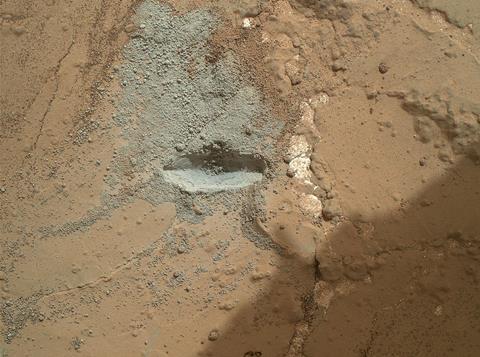
There are also theories that ‘recurring slope lineae’ (RSL) – linear structures on some crater walls – could be evidence of liquid perchlorate brines forming on the planet whose temperature averages below –60°C. ‘It turns out that perchlorate has one of the largest freezing point depressions for water of any anion – if it weren’t so toxic, you’d probably use it for de-icing your sidewalks,’ explains Bruce Parkinson, a chemist from the University of Wyoming in the US. While an oxidant when heated (ammonium perchlorate was used as the fuel in the space shuttles’ solid rocket boosters), it’s relatively stable at low temperatures and very soluble.
Perchlorates are found on Earth. High levels have turned up in Californian groundwater due to industrial pollution, but they are also found naturally in the Atacama Desert on the Pacific coast of South America. They are thought to form by the photochemical reaction of ozone with chloride aerosols high up in the stratosphere, and only persist in the driest regions where they are not washed away. But such mechanisms seem unlikely on Mars, with only traces of oxygen in its atmosphere, which is 95% carbon dioxide and 100 times less dense than Earth’s. Jon Telling, a geochemist at Newcastle University who is the PI on Edgar’s project, says there are also differences in the ratio of nitrates to perchlorates on Mars. ‘You’ve got about 1000-fold more perchlorate compared to nitrate than you do on Earth… which does suggest that you have additional processes for perchlorate generation.’
One theory, first proposed by Parkinson in 2011, is that the formation is driven by relatively high levels of UV light encountered on Mars, together with semiconducting titanium oxide minerals like rutile and anatase as a photocatalyst. ‘We took some TiO2 crystals that come in sodium chloride solution and shone UV light on them, and sure enough, we produce perchlorate from chlorides,’ says Parkinson. They found this worked with ice rather than water, but Parkinson and his collaborators also found that the destruction of perchlorate is additionally catalysed by these minerals, leading to a ‘photostationary state’ which they supposed could limit the production of perchlorate via this mechanism.
An idea that Parkinson thinks might explain how perchlorate persists and concentrates is its ability to depress the freezing point of water. ‘When you create a little of it near the surface, that keeps liquid water a little bit more stable. It would then be transported down below the photo zone and as you’ve concentrated more and more from the very surface to below, the lower and lower the freezing point would be and so you would continue to transport it deeper,’ he explains. Although water has not been found, surveys by the Compact Reconnaissance Imaging Spectrometer for Mars (CRISM) from 2006–2022 have confirmed the presence of hydrated perchlorate salts in RSLs, interpreted as the remains of such brines.
Mechanochemical mystery
Telling and Edgar don’t think this is the full story and have been looking at whether the movement of sand grains by wind can mechanically induce the chemistry needed to synthesise perchlorates. Telling previously studied the mechanochemistry associated with glacial action. ‘I got interested in where else these reactions could be interesting…one looked to be the surface of Mars,’ says Telling. To see if this was the case they simply crushed and milled silicates, such as olivine, (Mg,Fe)2SiO4, a common mineral on Mars. Results showed that reactive oxygen species were generated that could oxidise chlorides to perchlorates. ‘What you’re doing is breaking the strong covalent bonds between silicon and oxygen and in doing so, a subset of the bonds are split down the middle and form free radicals,’ says Telling.

The method seems to require some oxygen in the atmosphere, which may be an obstacle on Mars, plus with its thin atmosphere its winds are much lower than those on Earth. But Edgar thinks this would be enough to form sand dunes. ‘We see these glorious photos coming back from both the landers that we’ve got there,’ he says. ‘We’re not saying that this mechanism would replace other mechanisms, we’re saying that actually, it could be that they go very much hand in hand…that mechanical activation is a first step and then UV irradiation comes later on.’
An idea put forward independently by Alian Wang, a planetary spectroscopist at Washington University in St Louis US, and the late Nasa astrobiologist Rafael Navarro-Gonzalez, is that electrostatic discharge generated by dust storms play a role. Wang reported experiments producing electrostatic discharges in a chamber designed to simulate the Mars atmosphere and pressure. She detected atmospheric free radicals and was able to transform sodium chlorides into sodium perchlorates and perchlorites. She reported the oxidation power was three orders of magnitude higher than UV and photochemical processes alone. Navarro-Gonzalez suggested the mechanism could be initiated by ‘dust devils’ – strong dust-containing whirlwinds that can generate high electric fields and discharges. His team tried to simulate the affects using laser ablation of sodium chloride and the dust that formed contained some sodium perchlorate.
Even cosmic rays could have played a role, with another suggestion that radiation could cause the sublimation of chlorine oxides into the atmosphere, forming perchloric acid, which is deposited in the regolith.
The difficulty evaluating all these theories is the timescales involved, as perchlorates could have formed over millions of years, allowing low-yield processes to become significant. ‘It’s really hard to extrapolate [from] experiments we can do on Earth timescales in the lab,’ says Parkinson. And Mars may have had a very different environment 4 billion years ago and likely a much thicker atmosphere.
Mission impact
While we may never know the mechanism of their formation, Nasa and the European Space Agency have started to consider the impact of their presence on human exploration and perhaps ultimately on more permanent habitation. Archers says Nasa doesn’t consider their presence a ‘show-stopper’. ‘Perchlorate is known to be toxic to people, but only at really high doses,’ and he says it will be possible to filter it out of the air. ‘It becomes a more interesting problem once you start talking about growing plants in Martian regolith,’ he admits, but he has confidence that they will find methods to remove it from the soil or find plants that don’t uptake perchlorates into the edible parts.
As an expert in the biochemistry of oxidative stress as well as astrobiology, Georgiou Christos from the University of Patras in Greece has been interested in perchlorates as one source of reactive oxygen species. Experiments show they can form when perchlorates are activated by UV light or cosmic rays – in the reverse process to their synthesis. He says these radicals pose dangers to human health and could be corrosive to the metal parts of space stations.
If you add water to Martian soils, you’re going to release reactive oxygen species
An additional problem, according to Christos, is how perchlorates and ROS might interfere with the search for organic molecules that could point to life on Mars. It‘s now thought that perchlorates in soil samples collected by the Curiosity rover were responsible for the detection of low molecular mass chlorinated hydrocarbons from GC–MS analysis, which formed when samples were heated prior to analysis. ‘We know that if you add water to the [Martian] soils, you’re going to release reactive oxygen species which might oxidise all the organics that are in the soil, so you have to have some kind of a methodology before you expose the soils to experimentation,’ says Christos.
He is currently working with a Nasa scientist to develop a protocol for detecting bio-signatures in future space missions that will take into account the possibility of reactive oxygen species in samples. Archer says this is one of the reasons for the Mars Sample Return concept, allowing samples to be analysed more carefully back on Earth. Nasa and the ESA are planning a series of missions to return samples by the early 2030s.
With funding from the ESA, Christos and colleagues in Greece have also designed a prototype device, the size of a paperback, to quantitatively measure reactive oxygen species, which could be used by astronauts measure ROS levels inside space stations or on the surface of Mars. Their OxR instrument simply adds water to soil samples which will convert reactive oxygen species into gaseous oxygen to be detected by an electrode.
Jinjong Liu, a chemical engineer from the University of California Riverside in the US, has been experimenting with catalytic methods for reducing perchlorates to remove them from water. ‘The difficulty is that because it is intrinsically inert, most chemical reaction systems do not work very well in reducing perchlorate… typically they require heating to 80°C or sometimes over 100°C to accelerate the reaction,’ explains Liu. He has developed catalytic systems based on molybdenum and rhenium complexes with palladium on carbon. In the presence of hydrogen, perchlorate ions will be reduced to chlorides and water. The rhenium system is based on a rhenium(V) complex with two bindentate 2-(2’-hydroxyphenyl)-2-oxazolines ligands. Liu found that he could prevent the complex being attacked by highly reactive oxychloride intermediate ions if he added a methyl group to the oxazoline moiety to force the complex into an isomer that did not favour the complex reacting with the intermediates.
Looking for a cheaper alternative catalyst, Liu took inspiration from nature and the anaerobic microbes that can break down perchlorates with molybdenum-containing enzymes. He has also developed a molybdate catalyst, complexed with bipyridine ligands. Adding an amino group to the bipyridine ligands produced the most reactive system which was able to reduce 99.99% of perchlorate. ‘In the long term, I’m very optimistic that we will have other catalysts,’ says Liu.
A useful resource
Despite these issues, the high perchlorate levels on Mars may ultimately turn out not to be a problem, but a useful resource – providing oxygen for human explorers to breathe. As part of the 2020 Perseverance rover mission, Nasa demonstrated their Mars Oxygen In-Situ Resource Utilization Experiment (Moxie) electrolyser could produce oxygen on Mars by solid oxide electrolysis of carbon dioxide. But could ‘oxygen farming’ the Mars regolith be a plausible alternative? Simply heating the perchlorate-laden dust to above 500–600°C would release oxygen. Perchlorates are already used as an emergency oxygen generating system on the International Space station, with one litre of lithium perchlorate providing 24 hours of oxygen for one person.
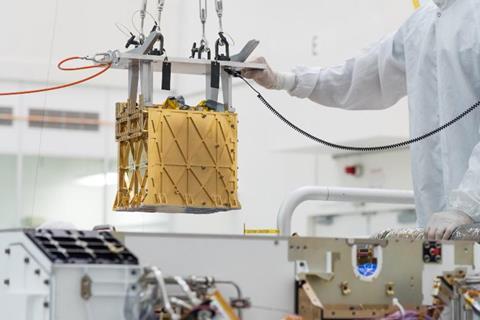
Another way that perchlorates could be processed has been posited by engineer Vijay Ramani from Washington University in St. Louis. He has suggested electrolysing perchlorate brines using a lead ruthenium oxide (Pb2Ru2O7) electrocatalyst anode and a platinum on carbon cathode. The complex mixed oxide has oxygen lattice vacancies, which allows it to conduct electrons, making it an exceptionally good catalyst for water splitting.
Ramani was initially looking for an idea that might interest the US Navy and designed the process to split sea water that could be useful for life support on submarines. Most catalyst will be poisoned by the salts in sea water, but Ramani found the efficiency stayed high with his system and then realised it may also work for electrolysing perchlorates on Mars. ‘The real question was would the perchlorates stick on to [the catalyst] and if they do, was it a physical absorption, which is easy to get rid of, or a chemical bond which then becomes problematic,’ says Ramani. Working at –36°C to simulating conditions on Mars, they were able to produce ultra-pure hydrogen and oxygen.
Ramani has done some back-of-the-envelope calculations and thinks for an equivalent power input, his catalytic process can produce 25 times the oxygen that can be produced by Nasa’s Moxie. Obviously his system will only work where perchlorate brines are present, whereas Moxie’s carbon dioxide feedstock is available everywhere on Mars. ‘We don’t want to convey a message that ours is better than theirs – it’s just a completely different approach to producing oxygen and hydrogen,’ he adds.
Producing oxygen on Mars is a major hurdle. Nasa estimates that launching a small crew from Mars will need 25 to 30 tons of oxygen which would require a 25–30kw power plant to produce using carbon dioxide electrolysis. It’s not clear what sort of contribution to this perchlorates could make.
The feasibility of a human missions to Mars by 2033 is still an issue. ‘Nasa knows how hard it is,’ says Parkinson, but he isn’t sure the same can be said for the billionaires like Elon Musk who have ambitions to colonise Mars. ‘[There are] so many problems you have to solve in order to get people there and [it’s] even harder to get them back.’
Chemical engineers Ramani and Liu are both confident it can be done. ‘I tend to be reasonably optimistic that you might be able to pull it off, it’s just the question of whether it’s worthwhile doing,’ says Ramani. In the end that may be a political rather than scientific question and one dependent on the public’s desire to get there. Nevertheless, Parkinson cautions us to stop and think about how difficult it will be. By comparison, getting to the moon would be like walking across the street, he says, but getting to Mars is like swimming to Hawaii.
Rachel Brazil is a science writer based in London, UK




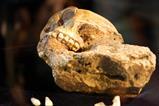
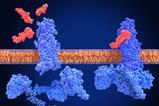
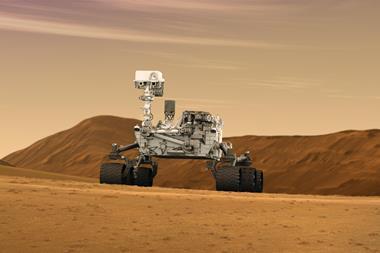

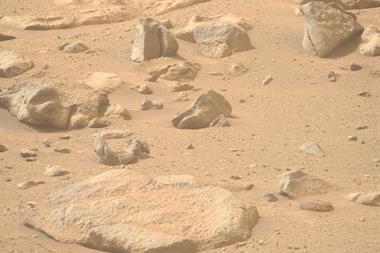

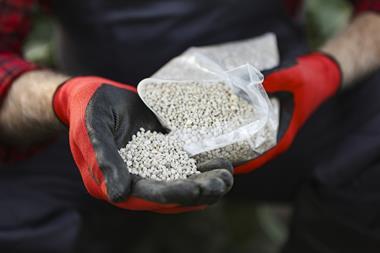







No comments yet